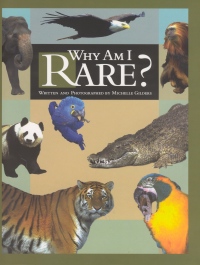| ________________
CM . . .
. Volume IX Number 12. . . . February 14, 2003
excerpt: If extinction is natural. you may think it doesn't matter if some species go extinct, especially when new species are being discovered every year. But we need all the species that exist. We need plants and animals for food, to clean our water, to give us medicines, and to use as fuel. Much of the oxygen we breathe comes from plants in the Amazon rainforest. Every time you take a breath of fresh air you are breathing in air made by plants half a world away! People enjoy nature. We live in a wonderful world. It would be very sad if we no longer had pandas, tigers, or whales to look at. But don't think that we should only save animals that are cute and cuddly. Even the smallest (or ugliest!) frog or insect is important to keeping nature healthy. We should save animals from extinction simply because we can. The first in a proposed series of six books, Why Am I Rare? introduces a selection of animal species facing extinction with a plea to young readers to consider how they might take an active role in conservation issues. Following several pages describing numbers of species worldwide, the main reasons some are classified as rare, and a brief explanation of the ways we value nature, author/biologist Michelle Gilders devotes the remainder of this 32 page book to individual species whose populations have decreased drastically in recent times. Scattered throughout the book are inserts defining scientific terms such as evolution, habitat, hybrid, etc. A single spread mentions "Conservation Success Stories." The final pages list suggested activities and learning opportunities for those concerned about helping to protect wildlife. A few websites are included for further information. Gilders is also a nature photographer and has contributed her own captioned images to the book. Liberally used, they include full-colour species closeups with backgrounds removed as well as shots of the animals in their natural habitat. The theme of this book is extremely worthwhile. The author's background as an environmental scientist lends accuracy to the content, and the choice of factual material will attract readers interested in this topic. Gilders has several adult nonfiction books to her credit on environmental issues. She does not appear as comfortable writing for younger readers. General statements do not anchor what may be new ideas in a child's experience with specific examples: "We need plants and animals for food, to clean our water, to give us medicines, and to use as fuel." Sweeping statements such as, "All species eventually become extinct," may invite challenge from the youngster who has learned cockroaches have existed since the time of dinosaurs. There is ambiguity in the author's discussion of "rare" on page 6: "If you live in North America, you might think that ...koalas...are rare because you never see one in the wild...but most species are only found in a few places. A species may be rare because its members only live on one small island..." The accompanying photo of a koala includes the caption: "Koalas are only found in Australia." It is unclear whether koalas are considered rare. The author tends to use abstract phrasing rather than specific descriptors: "We live in a wonderful world." "Tigers are beautiful cats." Imprecise language may leave readers guessing: "Lots of parrots are rare" and "lots of people live there [Madagascar]..." We are first told "there are hundreds of different species of parrots," but further down the same page we learn there are "more than 350 species of parrots." There are inconsistencies in the sequence of information within subtopics. Most species accounts deal with general facts and end, logically, with the future outlook. The section on elephants discusses their habits, their future, then closes with a paragraph on their intelligence. In addition, paragraphs are not well connected with transitions to help lead young readers through the information. The use of inserts to define key terms is less effective than a glossary would be in this type of book. For example, the term Ecosystem is first used on page 16, but not defined until page 27 where it is not used. Without an index, the book will find limited use as a research tool for the classroom. If readers use it as a starting point to a deeper understanding of their role in improving the welfare of Earth's species, then it may accomplish its objectives. This series' title, "Early Bird Nature Books," may mislead readers or teachers familiar with existing Language Arts series of the same title for beginning readers. Recommended. Gillian Richardson is a freelance writer and former teacher-librarian living in BC.
To comment
on this title or this review, send mail to cm@umanitoba.ca.
Copyright © the Manitoba Library Association. Reproduction for personal
use is permitted only if this copyright notice is maintained. Any
other reproduction is prohibited without permission.
Published by
NEXT REVIEW
|TABLE OF CONTENTS FOR THIS ISSUE
- February 14, 2003.
AUTHORS
| TITLES | MEDIA REVIEWS
| PROFILES
| BACK ISSUES
| SEARCH | CMARCHIVE
| HOME |
||
